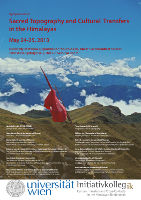Dear visitors,
please note that the Doctoral College (Initiativkolleg): “Cultural Transfers and Cross-Contacts in the Himalayan Borderlands” has ended and our website will no longer be updated.
For information on our ongoing research, events and activities please refer to the website of our Center for Interdisciplinary Research and Documentation of Inner and South Asian Cultural History (CIRDIS).
Symposium: Sacred Topography and Cultural Transfers in the Himalayas [24-25|05|2013]
Symposium: Sacred Topography and Cultural Transfers in the Himalayas
(Organization: Prof. Dr. Klaus-Dieter Mathes)
Time and place:
Friday+Saturday, 24th and 25th of May 2013; University of Vienna, Department of South Asian, Tibetan and Buddhist Studies, Seminar Room 1.
Download: Invitation [PDF]
Download: Program [PDF]
Abstract
An important aspect of our doctoral college on cultural transfers is the study of spatial transfers, namely, how certain aspects of Himalayan cultures can be located in geographical space in terms of trade route networks or pilgrimage routes and sites. Space and landscape are thus not only an objectively given geographic reality but also an environment that is fundamentally reconstructed by social, cultural, and religious meaning. For example, the pure visions of sacred mountains, rocks and lakes as the abodes of local, Bon, and Buddhist deities, or occasionally even as the proper deities themselves, did not only prepare the ground for pilgrimages with their related festivals and rituals, but were also important strategies used by competing schools and traditions to project their power into new areas. In this context, it is of particular interest how old local cults were incorporated, mostly in an inclusivist way, by more universal forms of religion, especially from India and the Southern Himalayas. This has to be seen against the backdrop of the Himalayas as a border area whose rugged terrain allowed both the development of cultural diversity and, at the same time, intercultural encounters.
The symposium aims at a larger framework of comparative approaches, which combines focused area studies, such as the documentation of Himalayan mountain cults or power places, with a broader interdisciplinary view of cultural processes in the fields of art history, imaginary geographies, South Asian, Tibetan, and Buddhist studies. State of the art discourses in the field start to replace essentialist notions of clearly demarcated entities, such as traditions, ethnic groups, or nation states, by concepts of dynamic processes of interconnections. This happened to the extent that one can already discern a paradigm shift to what we call cultural transfers and what has been occasionally labeled “entangled histories” (Randeria 2002), or “histoire croisée” (Werner & Zimmermann 2006).


